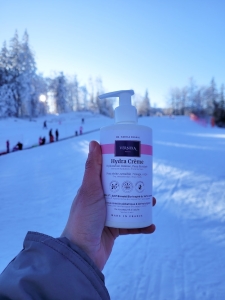Reading Time: mins
Dear parents, we know how important it is for you to take care of your baby’s delicate skin. 😊 Babies’ skin is so soft and sensitive, but it can also be prone to various irritations. In this “Baby Skin Irritation” article, we’ll explore the causes, symptoms and treatments for common baby skin irritations, based on scientific research. So grab a cup of tea, sit back and let’s discover together how to keep your baby’s skin happy and healthy. 😊
Although our content is based on reliable scientific and medical sources, and we have skin care experts on our team, it’s essential to understand that each case and situation is unique. The information provided on this site or in our articles should not be construed as medical advice. They are not intended to replace the recommendations or professional advice of a doctor, pediatrician or dermatologist. If you have any concerns or questions about your or your child’s skin health, we strongly advise you to consult a healthcare professional. Our content is provided for informational purposes only and should not be considered a substitute for professional medical advice, diagnosis or treatment.
Skin irritation in babies is a common phenomenon that can be caused by a variety of factors. Babies’ skin is particularly delicate and susceptible to damage from factors such as prolonged contact with urine or feces, rubbing, chemicals in care products, or even underlying medical conditions. Common symptoms include redness, itching, rashes and sometimes oozing. Understanding the underlying causes of these irritations is essential to treating them effectively. REF [^1^].
Skin irritation in babies generally manifests itself as redness, itching or rashes. These symptoms may be the result of allergic reactions, exposure to irritants or specific skin conditions such as eczema. REF [^1^].
Atopic dermatitis, also known as eczema, is a chronic inflammatory skin condition that can appear as early as the first few months of life. It is characterized by dry, red, itchy skin, rashes and dry skin. Research shows that atopic dermatitis is often linked to genetic factors and can be exacerbated by environmental factors such as dust, pollen and certain foods. REF [^1^].
Redness and rashes are common symptoms of skin irritation in babies. These symptoms can be caused by a variety of factors, including prolonged contact with irritating substances such as urine and feces, chemicals in wipes and diapers, or even allergic reactions to certain care products. REF [^1^]. It is essential to recognize and treat these symptoms promptly to avoid complications.
Diaper rash is a common form of skin irritation in babies. It is generally caused by prolonged contact of the skin with a damp layer. A recent study has shown that the best way to prevent and treat diaper rash is to ensure regular hygiene, change diapers frequently, and use specific protective creams. REF [^2^]. Research into the best methods of preventing and treating this condition has been underway for decades, highlighting its importance in the well-being of infants.
Diaper rash is caused by prolonged skin contact with urine or feces. Common symptoms include redness, swelling and peeling of the skin in the diaper area. In dermatology, desquamation refers to the loss of the superficial layers of theepidermisthe stratum corneum In dermatology, desquamation refers to the loss of the superficial layers of the epidermis, the stratum corneum, in the form of visible clusters of corneocytes known as “scales”. The term “exfoliation” is also used. REF [^2^].
A 2009 study examined the effect of baby wipes with emollient cleansers on stratum corneum integrity in neonatal intensive care infants. The results showed that the wipes were suitable for use on full-term and premature infants, and offered better skin barrier condition and function compared with the use of cloth and water. REF [^3^].
Be careful, though, about the type of wipes and their composition!
To prevent diaper rash, we recommend frequent diaper changes and the use of skin-friendly products. If diaper rash develops, it’s essential to keep the area clean and dry, apply a protective ointment, and consult a pediatrician if symptoms persist or worsen. REF [^2^].
Atopic dermatitis, often called eczema, is a chronic inflammatory skin condition that can affect babies as early as the first few months of life. It is characterized by itching, redness, rashes and dry skin. Although the exact causes of atopic dermatitis are not fully understood, it is often linked to genetic and environmental factors.
As mentioned above, atopic dermatitis is a common cause of skin irritation in babies. It is often associated with other allergic conditions such as asthma and hay fever. REF [^1^].
Symptoms of atopic dermatitis include redness, itching, rashes, dry skin and sometimes oozing. Before turning to treatment, it’s important not to use scouring or irritating products to clean baby’s skin. Treatments include regular moisturizing of the skin, the use of topical creams and, in severe cases, oral medication. REF [^1^].
If you have any concerns or questions about your or your child’s skin health, we strongly advise you to consult a healthcare professional. Our content is provided for informational purposes only and should not be considered a substitute for professional medical advice, diagnosis or treatment.
Eczema is a skin condition that can cause itching and rashes. It is often associated with allergies and can be triggered by factors such as food, chemicals and stress. REF [^1^].
Common symptoms of eczema include redness, swelling and itching. In some cases, the skin may also ooze or form scabs. REF [^1^].
In babies, eczema can appear on the face, arms, legs or other parts of the body. Symptoms can vary in severity, from slight redness to severe, oozing rashes.
Treatment of eczema in babies generally involves moisturizing the skin, using topical creams and taking antihistamine medication to reduce itching. REF [^1^].
Common treatments include moisturizers to keep skin hydrated, topical corticosteroids to reduce inflammation, and antihistamines to reduce itching. In all cases, consult a pediatric dermatologist without delay.
Dry skin is common in babies, and can be caused by factors such as cold weather, dry air and frequent bathing, or the use of inappropriate skin care products. Dry skin can cause itching, irritation, redness and tightness, so it’s important to keep baby’s skin well moisturized. REF [^1^].
Dry skin can appear rough and scaly. To treat dry skin, we recommend using gentle moisturizers such as Hydra Lavant and Hydra Crème from Vernixa, and taking lukewarm rather than hot baths. REF [^1^].
There are many other skin problems that can affect babies, such as cradle cap, food allergies and heat rash. It’s important to recognize these conditions and treat them promptly to avoid complications. REF [^1^].
Cradle caps; also known as seborrheic dermatitis; are yellowish scales that can appear on a baby’s scalp. They are caused by the accumulation of sebum and dead skin cells. REF [^1^].
Although cradle caps are generally harmless and disappear on their own, they can cause itching and discomfort.
Food allergies can cause a variety of skin symptoms in babies, such as rashes, hives and swelling. It’s important to recognize these symptoms and consult a pediatrician for proper diagnosis and treatment. REF [^1^].
Heat bumps are caused by obstruction of the sweat glands, resulting in the appearance of small fluid-filled blisters on the skin (small red bumps or blisters on the skin). They are common in babies because of their immature temperature regulation system. REF [^1^].
They are common in babies during the hot, humid months. Heat bumps can be uncomfortable, but they’re usually harmless and disappear on their own.
Diaper rash is caused by skin irritation in the diaper area. They can be caused by factors such as acidic stools, diaper friction and skin sensitivity. REF [^1^].
They can cause itching, redness and rashes in the diaper area. Prevention and treatment of diaper rash include proper care, adequate hygiene, frequent diaper changes and the use of skin-friendly products.
Taking care of baby’s delicate skin is essential to prevent and treat skin problems. This includes using mild cleansing products, moisturizing the skin regularly and consulting a doctor if symptoms are severe. REF [^1^].
We recommend bathing the baby in lukewarm water, using gentle, lipid-replenishing cleansers such as"Hydra Lavant“, and regular massages to improve circulation and relax your baby. After the bath, apply a moisturizing cream, such as"Hydra Crème“, to keep the skin well hydrated. REF [^1^].
It’s important to keep your baby’s skin clean to prevent infections. This includes: ( REF [^1^ ] )
For babies with very dry or atopic skin, it’s essential to use products specifically formulated for these conditions. This can include moisturizers, oils and balms, oatmeal baths and the use of mild detergents for clothing. REF [^1^]. It’s also important to avoid triggers such as harsh chemicals, perfumes and dyes.
Dear parents, we understand how important it is for you to take care of your baby's delicate skin. That's why we've developed a range of products specially formulated to meet the unique needs of babies' skin.
Our products are gentle, moisturizing, formulated with 100% natural ingredients and scientifically proven to moisturize, nourish and protect your baby’s skin. They are ideal for babies with sensitive, dry or atopic skin.
Find out how Vernixa® can help prevent skin irritation and soothe your baby’s skin. 🌿👶
All our products are tested under pediatric and dermatological control.
All Rights Reserved | Tous Droits Réservés GTIN Compliance Hydra Lavant | GTIN Compliance Hydra Crème



